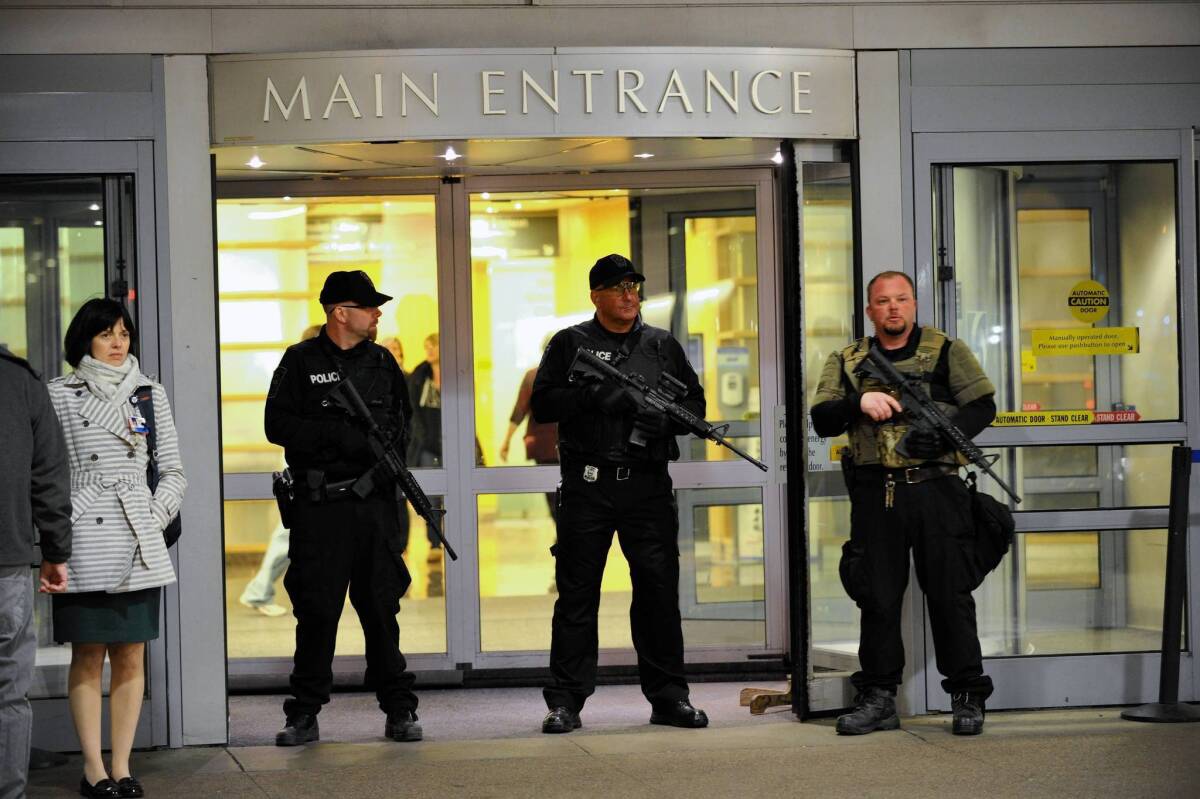Boston hospitals well prepared for blast casualties

- Share via
BOSTON — As 3 o’clock neared Monday afternoon, officials at Brigham and Women’s Hospital, one of Boston’s premier medical centers, expected this year’s marathon would be a nonevent.
“We were winding down,” said Barry Wante, the hospital’s emergency management director.
The slow pace was welcome after last year, when unseasonably warm weather led to a rash of heat injuries among runners, inundating the city’s hospitals.
Full coverage: Explosions at the Boston Marathon
But on Monday, the hospital’s radios suddenly crackled with reports from the finish line. Within minutes, the first ambulances arrived and the emergency department, like others across the city, was flooded with critically wounded runners and spectators, some with missing and shredded limbs, many bleeding profusely.
“It was a horrible scene,” said Dr. Michael Zinner, chief surgeon at Brigham and Women’s.
Authorities said Tuesday that 176 people were injured in the two back-to-back blasts.
On another day, in another city, Monday’s bombings might have overwhelmed local hospitals.
But Boston was fortunate to have six high-level trauma centers within a mile and a half of the bombing sites, including one for children. All of the hospitals had extra staff on hand for the marathon, which drew about 27,000 runners and hundreds of thousands of onlookers. Several surgeons on duty had worked in military hospitals in Iraq or Afghanistan.
Healthcare workers, police officers, firefighters and other emergency officials had spent years training for just such an emergency, a legacy of the Sept. 11, 2001, terrorist attacks. That experience meant the hospitals were well prepared to distribute the casualties among them.
“Everyone knew what we had to do,” said Dr. Stephen K. Epstein, an emergency physician at Beth Israel Deaconess Medical Center.
But emergency physicians and surgeons said Tuesday that no amount of practice could replicate the reality of treating so many casualties.
“We have seen our fair share of young people missing an arm or leg from an accident,” said Dr. Andrew Ulrich, executive vice chair of emergency medicine at Boston Medical Center, the city’s public hospital. “But the scale of this was completely different.... And there is something about the nature of the attack, the fact that someone set out to hurt people, that makes this more difficult emotionally.”
At Massachusetts General Hospital, doctors were confronted with multiple patients in need of amputations.
Severing a leg can be one of the toughest decisions a surgeon faces, said Dr. George Velmahos, the hospital’s chief trauma surgeon. In this case, though, the decision was already made, he said.
“We just finished the job the bomb did. Their limbs were completely mangled, some hanging by a shred,” he said. “There was no question whether these limbs would remain alive.”
Photos: Bombing at the Boston Marathon
Dozens of people remained hospitalized Tuesday night, many in critical condition, some facing more surgeries as doctors try to save badly damaged limbs and prevent infections, a persistent threat in blast wounds that lodge debris in victims’ bodies.
“These are tremendously dirty wounds,” said Zinner, comparing them to those suffered by soldiers injured by improvised explosive devices in Iraq and Afghanistan.
Patients at many hospitals suffered severe bone fractures, as well as nerve and muscle damage. Those closest to the blast were burned, and several were injured by shrapnel.
Some patients probably will have to live with that shrapnel, Velmahos said. “To chase after them would just create more damage.”
At least five people had limbs amputated, with one at Mass General at risk of losing his other leg. Most victims were injured in the legs; one patient at Brigham and Women’s suffered a severe head injury.
Dr. Paul Summergrad, chief of psychiatry at Tufts Medical Center, said some victims could also develop post-traumatic stress disorder in coming months.
But the casualties could have been worse had emergency responders and hospitals not reacted so quickly, officials said. That allowed the most critically ill patients to move rapidly from the bombing sites through emergency departments into surgery.
Full coverage: Explosions at the Boston Marathon
“One of the things we do learn from war is … how to treat the casualties better,” Zinner said. “We know there is this golden hour. And thank God, our medical teams were feet away.”
At Beth Israel Deaconess, the normal complement of 28 staffers in the emergency room ballooned to fives times that as doctors, nurses and others streamed back to the hospital. Officials at Brigham and Women’s said they deployed seven trauma teams to operate.
Mass General’s Velmahos said that 24 hours after the blasts, he felt more optimistic. “I’m more confident than I was in the morning that there will be no more loss of life,” he said.
More to Read
Sign up for Essential California
The most important California stories and recommendations in your inbox every morning.
You may occasionally receive promotional content from the Los Angeles Times.











